AP State Syllabus AP Board 6th Class Science Solutions Chapter 2 Knowing About Plants Textbook Questions and Answers.
AP State Syllabus 6th Class Science Solutions 2nd Lesson Knowing About Plants
6th Class Science 2nd Lesson Knowing About Plants Textbook Questions and Answers
Improve Your Learning
Fill in the Blanks.
1. Tap root system is present in ——– plants.
Answer:
dicot.
2. The bud at the tip of the stem is known as ——–.
Answer:
terminal bud.
3. Part of the leaf that helps in the exchange of gases is ——–.
Answer:
stomata.
4. Primary organs of photosynthesis are ——–
Answer:
Leaves.
![]()
Choose the correct Answer.
1. The important function of stomata is
A) Conduction
B) Transpiration
C) Photosynthesis
D) Absorption
Answer:
B) Transpiration
2. Part of plant that helps in absorption of water and minerals
A) Root
B) Stem
C) Leaf
D) Flower
Answer:
A) Root
3. Part of the stem from where leaves arise is called
A) Node
B) Bud
C) Cotyledon
D) Internodes
Answer:
A) Node
Answer the Following Questions.
Question 1.
What are the important parts of a plant?
Answer:
The important parts of a plant are: a) Roots, b) Stem, c) Leaves, e) Flower and e) Fruit.
Question 2.
How does the stem help the plant?
Answer:
The stem of a plant,
- supports the branches, leaves, flowers and fruits.
- transports water and minerals from roots to upper aerial parts of the plant.
- transports food from leaves to other parts.
- in some plants, it stores the food so that they are known as the modified stem.
Ex. Potato, turmeric, ginger, garlic and sugarcane.
![]()
Question 3.
What is the relation between the type of root system and venation?
Answer:
The relation between the type of root system and leaf venation is,
a) The plants having tap root system has reticulate venation.
b) The plants having a fibrous root system has parallel venation.
Question 4.
Rajani said “Respiration takes place in leaves” she correct? How can you support this statement?
Answer:
- What Rajani said is correct.
- The leaves of plants have tiny pores on their surface, which are called stomata.
- Stomata acts like a nose to the leaf.
- So that exchange of gases in the leaves takes place through stomata during respiration.
Question 5.
What will happen if a plant does not have any leaves?
Answer:
- Leaves are the sites of photosynthesis for the preparation of food.
- Gaseous exchange in plants takes place through leaves by the process of respiration.
- Excess of water in the plant is removed in the form of vapours through the leaf surface.
- If the plant does not have any leaves it will not able to make its own food and cannot perform the functions of respiration and transpiration.
- Stem can perform these functions in those plants that does not have leaves.
Question 6.
How can you show that plants absorb water through their roots?
Answer:
Aim: To observe the absorption of water by root.
What you need: A carrot, a glass of water and blue ink.
What to do:
- Take a glass of water and add a few drops of blue ink to it.
- Now place a carrot in the glass.
- Leave the carrot in water for 2 or 3 days.
- Then cut the carrot in water, lengthwise and observe.
What do you see: Blue colour appears in the carrot.
What do you learn: The blue colour indicates that water moved upward in the carrot showing that root absorbs water.
Question 7.
Explain the various parts of a plant with the help of a diagram.
Answer:
The important parts of a plant are:
a) root b) stem c) leaf d) flower e) fruit
a) Root: The underground part of the main axis of the plant is the root.
- Roots absorb water and minerals from the soil.
b) Stem: The aerial part of the plant above the ground is the stem.
- It bears branches, leaves, flowers and fruits.
- It transports water, minerals and nutrients to the various parts.
c) Leaf: The flat, green portion of a plant that arises from a node is a leaf.
- It helps in photosynthesis, respiration and transpiration.
d) Flower: The bright and beautiful part of the plant.
- It is a reproductive part of a plant.
e) Fruit: It is an edible part of a plant that contains seeds.
- It developed from the flower.
![]()
Question 8.
Explain the parts of a leaf with the help of a diagram.
Answer:
The main part of a leaf is,
a) Leaf base b) Petiole c) Lamina d) Midrib e) Veins
a) Leaf base: Lower part of the leaf that joins the leaf to the stem near the node.
b) Petiole: A stalk-like/structure that connects leaf to the stem of the plant.
c) Lamina: The thin, flat, green portion of the leaf is lamina.
d) Midrib: The long vein that present in the middle of the lamina.
e) Veins: The branches arising from the midrib and spread over all the lamina.
Question 9.
John has no sufficient place around his house to grow plants. But he wants to grow vegetables like tomato or brinjal. Suggest him some ways to grow plants.
Answer:
Terrace garden, Kitchen garden, Vertical garden are some methods for growing the plants in limited space.
a) Terrace garden: It is a simple garden growing on the terrace. In this process, we use water bottles, plant pots and other waste vessels to grow the plants.
b) Kitchen garden: A garden in which plants for use in the kitchen are cultivated.
c) Vertical garden: A garden in which the plants are supported to grow vertical, especially fences, posts, walls rather than along the ground.
Activities and Projects
Question 1.
Collect any plant from your surroundings. Draw its root structure. What can you say about its root system?
Answer:
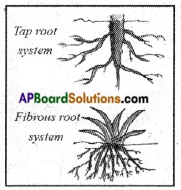
- The root system collected in the plant exhibit tap root system.
- In this plant, the main root is thick and grows straight down into the ground is Tap root.
- And the smaller roots arising from the tap root are Lateral roots.
- The root system helps the plant to penetrate into deep layers of the soil.
(OR)
- The root system collected in the plant exhibit tuberous root system.
- In this plant all roots are thin and uniform in size.
- This root system consists of a cluster of roots arising from the base of the stem.
- The root system helps the plant to hold the soil firmly and prevent soil erosion.
Question 2.
Collect the leaves of various plants and prepare a herbarium. Write a brief report on their shapes size and venation.
Answer:
Students collect different shapes and sizes of leaves.

- A Herbarium is a store house of plant specimens which are collected, dried and mounted on paper sheets.
- There are different shapes such as linear, elongated elliptical etc.
- The collected leaves showing reticulate venation and parallel venation in some plants.
![]()
Question 3.
Prepare a greeting card with dry leaves.
Answer:
The student can prepare this in a way of his choice. (Student Activity)
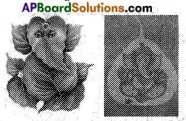
Question 4.
Observe a plant that has healthy green leaves and beautiful flowers. Write your feelings about the plant in your note book.
Answer:
- When we see a plant with healthy green leaves and beautiful flowers, we wonder at the glance of such point.
- The green colour of the leaves gives us good scenery and good visibility.
- Green colour is pleasant to our eyes so that it is quite healthy for our eyes.
- On seeing the healthy plant, our mind gets refreshed and tries to forget all the worries.
- The colour and beauty of the flowers makes us relax and its fragrance gives us aroma.
6th Class Science 2nd Lesson Knowing About Plants Activities
Activity – 1
1. Collect 5 or 6 different types of plants from your garden. (Page No. 13)
a) Observe the collected plants and try to identify their parts. Take the help of fig. 1 in your text book and write your observations in Table given Let us discuss the following questions.

Answer:
| Sl.No. | Name of the plant | Root Yes/No |
Stem Yes/No |
Leaves Yes/No |
Flower Yes/No |
| 1. | Rice | Yes | Yes | Yes | Yes |
| 2. | Tulasi | Yes | Yes | Yes | Yes |
| 3. | Mango | Yes | Yes | Yes | Yes |
| 4. | Rose | Yes | Yes | Yes | Yes |
| 5. | Neem | Yes | Yes | Yes | Yes |
i) Did you find any plant which does not have roots?
Answer:
No. I don’t find any plant without roots.
ii) Are the leaves of all plants similar in size?
Answer:
No. The leaves of all the plants are not in similar in size.
iii) Is there any plant without flowers?
Answer:
Ferns, mosses and liverworts are non flowering plants.
iv) What are the common parts that you observe in all plants?
Answer:
Roots, stem, leaves and flowers are the common parts that I observed in all plants.
v) Observe the roots of the plants you collected. How are they?
Answer:
They are not alike.
vi) Do all plants have a similar type of root?
Answer:
No, they have different roots.
vii) Is there any difference?
Answer:
Yes, we can observe the differences some plants have tap root system and some have fibrous
![]()
b) Compare the roots of your sample plants with pictures fig 2 and fig 3 and write your observations in table and answer the following questions.
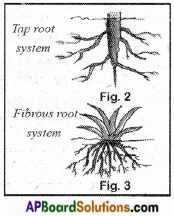
| S.No. | Name of the plant | Type of root system |
| 1. | Tridax plant | |
| 2. | ||
| 3. | ||
| 4. | ||
| 5. |
Answer:
| S.No. | Name of the plant | Type of root system |
| 1. | Tridax plant | Tap root system |
| 2. | Rice | Fibrous root system |
| 3. | Tulasi | Tap root system |
| 4. | Mango | Tap root system |
| 5. | Rose | Tap root system |
| 6. | Neem | Tap root system |
i) In the tap root system, how does the middle root look like?
Answer:
Middle main root become thick and has thin rootlets.
ii) Compare the middle root with the remaining roots in the tap root system?
Answer:
The middle root is thick and known as Tap root, and the remaining rootlets are thin and known as Lateral roots.
iii) Do you find any such main root in fibrous root system? How are the roots of this plant?
Answer:
No. There is no main root in fibrous root system. Here all roots are similar in size.
iv) Do you find any other differences between tap root system and fibrous root system?
Taproot system consists of Taproot and Lateral roots in different sizes whereas in fibrous root system all roots are thin and uniform in size.
![]()
Activity – 2
2. Write an activity to identify an emerging point that belong to either monocot or dicot in your science lab. (Page No. 14)
Answer:
Aim: To observe the cotyledons of bean seeds and finger millets comparatively with their root systems.
What you need: Two paper cups, soil, bean seeds, finger millet seeds, water.
What to do?:
- Take two paper cups and fill them with fertile soil.
- Sow 2 or 3 bean seeds in a cup and few finger millets in another cup.
- Sprinkle water over them.
- After a couple of days, we will see the sprouts.
- Observe the newly emerging leaves of that sprouts.
- Take out the plants out of the soil carefully and observe their roots.
What do you see: Two leaves are emerged from the bean seed and only one leaf emerged from the finger millet seedlings. These are the cotyledons.
- Bean has two cotyledons so it is a dicot plant.
- Finger millet has one cotyledon so it is a monocot plant.
- Bean plant has tap root system whereas finger millet has fibrous root system.
What do you learn:
- Dicot plants have tap root system whereas monocot plants have fibrous System.
- So that there is a relation between the cotyledons and the root system.
Activity – 3
Water absorption by Root. (Page No. 13)
3. How can you explain that plants absorb water through their roots?
Answer:
Aim: To observe the absorption of water by root.
What you need: A carrot, a glass of water and blue ink.
What to do: Take a glass of water and add a few drops of blue ink to it.
- Now place a carrot in the glass.
- Leave the carrot in water for 2 or 3 days.
- Then cut the carrot in water, lengthwise and observe.
What do you see: Blue colour appears in the carrot.
What do you learn: The blue colour indicates that water moved upward in the carrot showing that root absorbs water.
- Observe the figure. Which part of the plant does that boy hold to swing?

Answer:
Roots of Banyan (Aerial roots).
![]()
Activity – 4
4. How can you prove that the water absorbed by the root is carried cut through stem to all parts of the plants?
Answer:
Aim: To observe the conduction of water by a stem.

What you need: A small twig of balsam plant, a glass of water, red ink.
What to do: Take a glass of water and add a few drops of ink to it.
- Now place the small twig in the water.
What do you see: The stem turns reddish.
What do you learn: The red ink is taken and transported by the stem upwards.
Observe the given picture of a leaf and its parts.
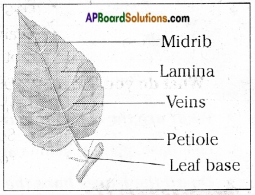
- Where is the leaf attached to the stem?
Answer:
Leaf base. - What is the flat portion of the leaf called?
Answer:
Lamina (or) Leaf plate. - What do you call the small line like structure in the flat portion of the leaf?
Answer:
Veins. - Which part connects leaf lamina with the stem?
Answer:
Petiole.
Activity – 5
Are all leaves the same? (Page No. 17)
5. a) Observe the leaves of the plants that you collected in activity 1.
- How are they?
Answer:
They are thin and flattened green structures. - Are all the leaves being same size and shape?
Answer:
No. The leaves are not the same size and shape.
b) Compare the leaves of the plants collected in activity 1. Write your observation in the table given. You can also draw what you see in the shape and edge columns if describing is difficult.
| S.No. | Name of the plant | Leaf base Yes/No | Petiole Yes/No |
Lamina Yes/No |
Shape of the leaf | Edges of the leaf |
| 1. | ||||||
| 2. | ||||||
| 3. | ||||||
| 4. | ||||||
| 5. |
Answer:
| S.No. | Name of the plant | Leaf base Yes/No | Petiole Yes/No |
Lamina Yes/No |
Shape of the leaf |
Edges of the leaf |
| 1. | Rice | Yes | No | Yes | Linear | Hairy |
| 2. | Tulasi | Yes | Yes | Yes | Oval | Slightly toothed |
| 3. | Mango | Yes | Yes | Yes | Oval | Smooth |
| 4. | Rose | Yes | Yes | Yes | Oval | Sharply toothed |
| 5. | Neem | Yes | Yes | Yes | Linear | Dentate |
- What are the common parts that you observe in all the leaves?
Answer:
Leaf base, petiole, lamina are the common parts I observed in all the leaves. - Do all the leaves have the same shape?
Answer:
No. All the leaves have not the same shape.
![]()
Activity – 6
6. Put a leaf under a white sheet of paper or a sheet in your notebook. Hold the tip of the pencil flat and rub it on the paper. (Page No. 18)
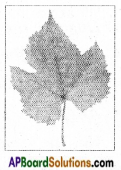
- Did you get any impression?
Answer:
Yes. I get the impression of leaf. - Is this pattern being similar to that of the leaf?
Answer:
Yes. It is similar to that of the leaf.
Activity – 7
Types of Venation. (Page No. 18)
7. Observe the venation of the leaves that you collected in activity 1. With the help of fig. 6 right your observations in table 4.

| S.No. | Name of the Plant | Venation (Reticulate / Parallel) |
| 1. | ||
| 2. | ||
| 3. | ||
| 4. | ||
| 5. |
Answer:
| S.No. | Name of the Plant | Venation (Reticulate / Parallel) |
| 1. | Rice | Parallel venation |
| 2. | Tulasi | Reticulate venation |
| 3. | Mango | Reticulate venation |
| 4. | Rose | Reticulate venation |
| 5. | Neem | Reticulate venation |
a) Now compare the results obtained in table-2 with table-4.
- What type of roots are there in plants having parallel venation in their leaves?
Answer:
Fibrous roots are there in plants having parallel venation in their leaves. - What type of roots are there in plants having web-like venation in their leaves?
Answer:
Taproot system is there in plants having web-like venation in their leaves. - Is there any relation between venation and root system?
Answer:
Yes. There is a relation between venation and the root system.
The plants with taproot system have leaves with web-like or reticulate venation and plants with fibrous roots have parallel venation.
![]()
Activity – 8
Stomata Observation. (Page No. 19)
8. What procedure do you follow to observe the stomata in your school lab?
Answer:
Aim: To observe stomata in a leaf.
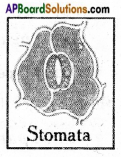
What you need: Fleshy leaf, water, microscope, slide.
What to do:
- Take a fleshy leaf.
- Peel the outer layer of the leaf and place it on a slide.
- Put a drop of water on it and observe it under a microscope.
What do you see: We find some bean-shaped parts.
What do you learn: The bean-shaped parts are stomata. Its acts like our nose.
Activity – 9
Transpiration. (Page No. 19)
9. Write an activity to explain transpiration in plants.
Answer:
Aim: To observe that excess water is removed in the form of vapours from the leaf surface.

What you need: Well-watered potted plant, polythene bags, thread.
What to do:
- Take a well-watered potted plant.
- Enclose a leafy branch of the plant in a polythene bag and tie its mouth.
- Take another polythene bag and tie its mouth without keeping any plant.
- Keep both polythene bags under the sun.
![]()
What do you see:
- We see some droplets in the polythene bag that ties on the plant.
- There are no droplets in another polythene bag.
What do you learn: Plants release excess water in the body through the stomata of the leaves.
- This process of releasing water in the form of vapour by the process called transpiration.